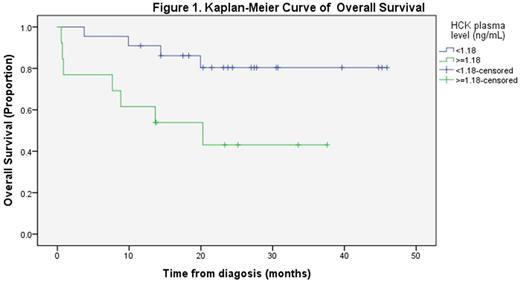Abstract
Background
Leukemia stem cells (LSC), which are enriched in the CD34+/38- compartment of blasts, have been widely studied over the past 2 decades. High LSC load at diagnosis has been shown to be associated with resistant disease and inferior survival. However, quantification of LSC has been challenging. A surrogate biomarker for LSC population could be useful in predicting outcome.
Hematopoietic cell kinase (HCK) is a member of the Src family of tyrosine kinases that is usually expressed in hematopoietic stem cells. It has been shown to be overexpressed in myeloid disorders, multiple myeloma, and some lymphoproliferative diseases. HCK activation has also been described in solid organ tumors where it is associated with chemotherapy resistance.
In a study by Saito et al, HCK was shown to be overexpressed in the LSC compartment (CD34+/38-). This study aims to evaluate the prognostic significance of HCK protein levels in the plasma of acute myeloid leukemia (AML) patients. We hypothesize that high levels of HCK protein expression in the plasma at diagnosis is associated with poor prognosis among patients with AML.
Methods
Peripheral blood samples were collected from patients with newly diagnosed AML from Jan 2013 to Aug 2016, after informed consent was given. Plasma HCK protein levels were measured using a commercially available ELISA kit. The level of protein expression in the plasma was determined in 87 normal blood donors and 39 AML patients. The HCK plasma protein levels in AML patients were correlated with clinical outcome, which include complete remission rate, relapse rate, leukemia free survival and overall survival. Receiver operating characteristic (ROC) curve analysis was used to determine the optimal cut-off level for respective clinical end points.
Results
36 AML patients who were treated with curative intent were included in this study. Median age was 48 years (range: 22 to 74 years). 87.5% of the patients achieved complete remission (CR), and 42.9% of those who achieved CR eventually relapsed. Overall median follow up was 24.4 months (IQR: 12.1 to 27.7 months). Median overall survival (OS) was not reached. 2-year OS was 66.9%.
The plasma level of HCK in the normal blood donors ranged from 0.0047 to 0.0338 ng/mL with a mean of 0.0056 ng/mL (SD: 0.0043 ng/mL). The plasma levels of HCK in the AML patients ranged from 0.44 to 5.18 ng/mL, with a mean of 1.23 ng/mL (SD: 0.84 ng/mL).
Using ROC curve analysis, it was determined that a HCK level higher than or equal to 1.18 ng/mL was predictive of mortality, with a sensitivity of 0.64 and a specificity of 0.76 (AUC: 0.65).
Using Kaplan-Meier analysis, patients with higher levels of HCK had inferior survival. The 2-year OS was 43.1% and 79.7% for those with HCK level ≥1.18ng/mL and <1.18ng/mL respectively ( P =0.016). Patients with higher levels of HCK ≥1.18ng/mL also had a trend towards poorer leukemia free survival compared to those with lower levels of HCK <1.18ng/mL, but this was not statistically significant.
Conclusion
Plasma HCK is a biomarker that is helpful in identifying AML patients with poorer prognosis. This test can potentially be used in the clinical setting as it is easy to perform. We plan to validate our findings in a larger cohort of AML patients.
Chng: Janssen China R&D: Research Funding.
Author notes
Asterisk with author names denotes non-ASH members.


This feature is available to Subscribers Only
Sign In or Create an Account Close Modal